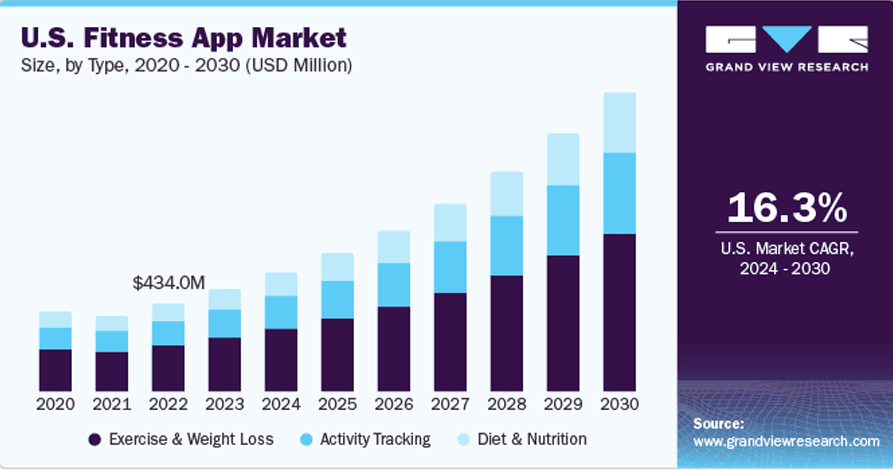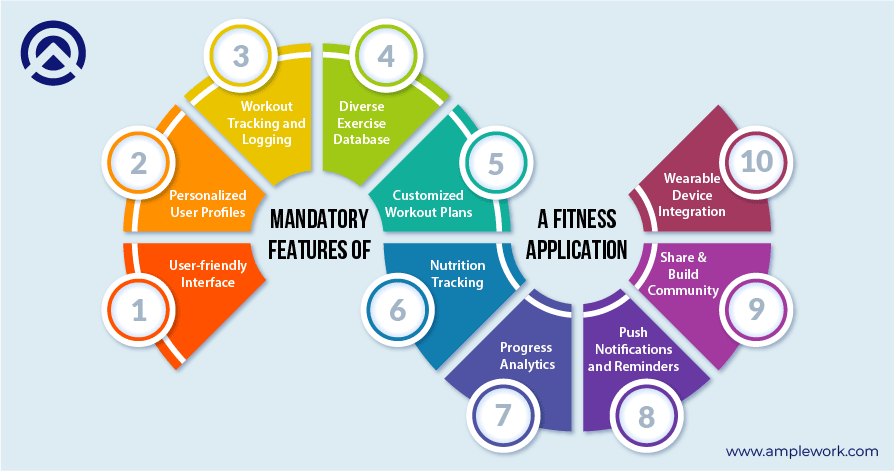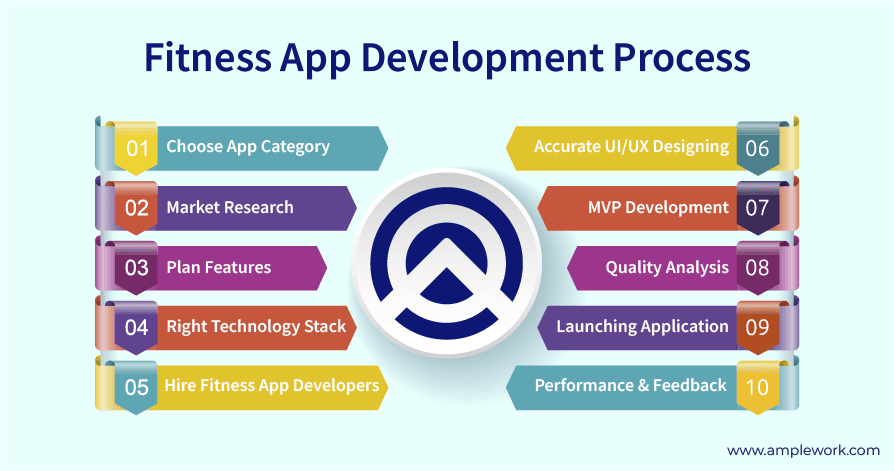Building a Fitness App: A Step-by-Step Development Roadmap
Don’t you think fitness has now become a major consideration of many people on a global scale. The current times are all about getting digitally advanced and monitoring fitness through an application treated as the best option in this realm. These tech innovations have become more than just applications in people’s lives. Well, they fulfill the role of lifestyle companions, wellness advisors, fitness mentors, and many more, constructed within one application. In other words, these applications are helpful when you are completely busy with your working schedule or personal responsibilities. The major advantages of fitness apps they help in tracking fitness details, dieting plans, health progress, completion of health goals without any burden, and cost-effective solutions. The research data by Grand View Research highlights the same aspects.

According to the above figure, the fitness app market size was valued at USD 1.54 billion in 2023. That is expected to grow at a compound annual growth rate of 16.3% within the time frame of 2024 to 2030. This is a clear indicator of how fast the expansion of these applications is increasing and has such future expectations. As we all know successful execution of any idea can only be performed when you follow an adequate roadmap or guideline. So for an accurate health and fitness app development practice, one needs to follow a proper roadmap.
Blog Highlights
This blog is all about devolving into the heart of fitness app development practices. As they have an important significance in our lives and are continuously helping to deal with different health conditions. The major highlights of this are mandatory features to be added and a step-by-step development guide for developing a fitness app. Let’s give this a quick read attaining proper guidelines.
Mandatory Features of a Fitness Application

1. User-friendly Interface
A seamless and intuitive user interface is paramount for a positive user experience. Ensure that users can easily navigate through the app, access essential features, and track their progress effortlessly. Incorporate visually appealing design elements, intuitive icons, and straightforward menu structures. To enhance the usability of the health and fitness app development solutions.
2. Personalized User Profiles
This allows users to create personalized profiles, enabling them to input crucial information such as age, weight, fitness goals, and any health considerations. This data serves as the foundation for tailoring workout plans and recommendations. Additionally, provides the option for users to update their profiles as their fitness journey progresses.
3. Workout Tracking and Logging
Implement a robust system for tracking and logging workouts. Users should be able to record their exercises, set goals, and monitor their progress over time. Include features like real-time data updates, the ability to add notes or reflections, and the option to track different workout metrics such as duration, intensity, and calories burned.
4. Diverse Exercise Database
Offer a comprehensive database of exercises covering various fitness levels and categories. Include clear instructions, images, or videos to guide users in performing each exercise with proper form. Regularly update the exercise library to introduce new routines, keeping the app’s content fresh and engaging.
5. Customized Workout Plans
Provide users with the option to create personalized workout plans based on their fitness goals, preferences, and time constraints. A tailored approach enhance customer engagement and ensures users stay committed to their fitness routines. Include pre-designed plans for different fitness levels and goals for users who prefer ready-made routines.
6. Nutrition Tracking
Integrate a nutrition tracking feature that allows users to log their daily food intake. This feature should include a food database with nutritional information, the ability to set dietary goals, and features like barcode scanning for easy input. Consider partnering with nutritionists to provide expert advice and recommendations within the app.
7. Progress Analytics
Implement analytics tools to track and visualize users’ progress. Charts, graphs, and statistics can offer a detailed overview of achievements, fostering motivation and helping users stay on track. Include milestone celebrations and personalized insights to make the progress-tracking experience more rewarding.
8. Push Notifications and Reminders
Enable push notifications and reminders to keep users engaged and informed about their workout schedules, meal plans, and any other relevant updates. This feature helps maintain consistency in their fitness routines. Allow users to customize notification preferences to suit their individual preferences and schedules.
9. Social Sharing and Community Building
Integrate social sharing features to allow users to share their achievements, workout routines, and progress with their social networks. Additionally, creates a community within the app where users can connect, share experiences, and provide mutual support. Implement features like challenges, leaderboards, and group workouts to foster a sense of community.
10. Wearable Device Integration
Support integration with popular fitness wearables and devices. This allows users to seamlessly sync data, such as step counts and heart rate, providing a more comprehensive overview of their overall health. Explore partnerships with wearable manufacturers to enhance compatibility and provide users with a seamless fitness-tracking experience.
Related Blog: Outside Fitness Trackers: The Expanding Horizon of Wearable Technology in Business
Step-by-Step Guide to Fitness App Development Process

1. Choose the Right Category
Fitness tracking apps use smartphones and wearable sensors to monitor physical activity, promoting a healthier lifestyle. Nutrition apps aid in meal planning, calorie counting, and nutrient tracking, fostering informed dietary choices. Yoga and meditation apps offer mindfulness exercises, accommodating users of all levels, with features like progress tracking and personalized recommendations. Workout apps provide diverse exercise options, enhanced by gamification for user engagement. These apps, exemplified by Google Fit, contribute to holistic well-being and fitness success. Nutrition apps, like dietitian-supported options, guide users toward healthier eating habits. Yoga apps, such as Yoga Studio and Headspace, cater to mindfulness and flexibility. Captivating workout apps, featuring VR exercises or unique routines, differentiates in the competitive fitness market, attracting a broad audience.
2. Conducting market research
Conduct comprehensive market research, scrutinize competitors, and pinpoint market voids to establish key objectives for your fitness app. Delve into your target audience’s desires, preferences, and motivations to craft a fitness app that precisely caters to their needs. A thorough analysis of the market landscape ensures a strategic approach, allowing you to align your app’s features with the identified gaps and deliver a product that resonates with your audience. By understanding the competition and intricacies of user expectations, you can strategically position your fitness app, enhancing its appeal and effectiveness in meeting the diverse requirements of your target demographic.
3. Planning Application Features
Incorporate findings from your research and insights into your target audience to identify crucial features for your fitness app. Select features that not only align with user preferences but also establish a distinctive value proposition, setting your app apart in the competitive landscape. These chosen features should serve a dual purpose: meeting the specific needs of your audience and contributing to the uniqueness of your business. By strategically integrating features that resonate with users and differentiate your app, you enhance its appeal, fostering a competitive edge and attracting a user base that values the distinct offerings of your fitness application.
4. Selecting the Right Technology Stack
Opt for suitable technologies, frameworks, and development tools, emphasizing cross-platform compatibility, scalability, and maintainability. Choose a framework like React Native or Flutter that aligns with your project’s goals, ensuring efficient development. Additionally, explore third-party API integrations relevant to health and fitness app functionalities. This strategic selection of technologies and frameworks optimizes the app’s performance, scalability, and long-term maintainability. By considering cross-platform capabilities and integrating key APIs, you enhance the overall functionality of your health and fitness app, providing a seamless experience for users while streamlining development processes and future scalability.
5. Hiring the best Fitness app developers
Assemble an adept team of fitness app developers by factoring in considerations like cost, commitment, availability, and project requirements. Opt for an in-house team if direct communication and control are paramount. Alternatively, engage an offshore fitness app development company for access to skilled fitness app developers, offering flexibility and expertise. For specialized skills or smaller-scale projects, consider hiring freelancers. Tailor your mobile fitness app developers team selection to align with the specific needs and scale of your fitness app project, ensuring a harmonious balance between expertise, cost-effectiveness, and project management efficiency. This strategic approach enhances the overall development process and contributes to the success of your fitness app.
6. Creating User Accurate UI/UX designing
Craft an intuitive, visually pleasing, and user-friendly interface for your fitness app to elevate the overall user experience. Prioritize design elements that facilitate easy navigation, ensuring users can seamlessly interact with the app. Emphasize inclusivity by making the app accessible to users with varying fitness levels and abilities. By implementing a thoughtful and user-centric design, you enhance engagement and satisfaction. Ensure that the interface not only aligns with aesthetic appeal but also promotes a positive and inclusive user experience, fostering broader accessibility and usability for a diverse user base.
7. MVP Development
Develop a minimum viable version (MVP) of your fitness app, concentrating on essential features and functionality. The MVP serves as a practical prototype, enabling you to assess the app concept with real users, collect valuable feedback, and validate its market potential. This iterative approach mitigates risks by allowing you to refine and enhance the app based on user input before committing additional time and resources to MVP development. Building and testing the MVP provides crucial insights, ensuring that subsequent development phases align more closely with user needs and preferences, ultimately optimizing the success and viability of your fitness app in the market.
8. Conducting Quality Analysis of the App
Execute rigorous testing to verify the app’s functionality, usability, and performance align with your intentions. Employ a comprehensive approach encompassing both manual and automated testing methods. Explore beta testing with actual users to gather valuable feedback and pinpoint any potential issues or bugs that require attention. This meticulous testing phase ensures the app’s reliability and user satisfaction. By combining various testing methodologies, you can identify and rectify issues efficiently, enhancing the overall quality and performance of your fitness app before its official launch. This strategic testing process contributes to a seamless user experience and bolsters the app’s success in the competitive market.
9. Launching Application
Launch your app on the relevant app stores, adhering to their guidelines. Optimize your app store listing with relevant keywords, compelling descriptions, and appealing visuals to enhance visibility and drive downloads. Align with each platform’s requirements for a smooth release. Strategic app store optimization improves your app’s discoverability, making it more attractive to potential users. By following best practices and guidelines, you increase the likelihood of standing out in a crowded marketplace, ultimately leading to higher visibility, increased downloads, and a successful app launch.
10. Performance Analysis and User Feedback
Consistently track app usage, user feedback, and app store ratings to pinpoint areas for improvement and identify growth opportunities. Consider partnering with a top fitness app development company capable of updating and enhancing your app according to user feedback and market trends. This strategic collaboration ensures the sustained engagement and satisfaction of users by keeping the app aligned with evolving preferences and industry standards. By staying attuned to user insights and leveraging the expertise of a reputable development partner, you can proactively address issues, implement enhancements, and position your fitness app for continued success in a dynamic market landscape.
Wrapping Up
In the realm of fitness applications, ensuring a seamless and secure experience for users on their health and wellness journey is of utmost importance. Robust protection for personal health data is a necessity when engaging with these apps, designed to cater to a wide range of fitness needs. The increasing demand for reliable and secure fitness solutions has prompted forward-thinking developers and health institutions to prioritize the protection of users’ health information. While facing initial challenges in this field, many have successfully positioned themselves as pioneers in developing secure fitness apps. In today’s dynamic health and wellness landscape, the widespread adoption of intelligent digital solutions has become more accessible. This empowers both users and fitness institutions to seamlessly adapt to the evolving demands of modern health tracking while guaranteeing the safety of personal health information.
Amplework, a leading mobile app development company with over 5+ years of immersive experience, understands the critical significance of security in fitness apps. Our dedicated team consistently surpasses client expectations, earning a reputation for reliability and trustworthiness. We have achieved noteworthy milestones by supporting various health organizations, all while adhering to the highest security standards. Explore our website to uncover the exceptional fitness app development services we offer. Choose to partner with Amplework for a transformative journey towards ensuring the robust security of users’ health information in the world of fitness apps.
You May Also Read:- Way for Smart Farming Solutions


 sales@amplework.com
sales@amplework.com
 (+91) 9636-962-228
(+91) 9636-962-228





